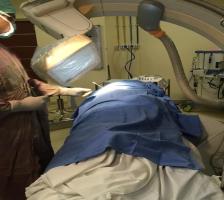
Spinal pain in the lumbar region (lower back) and cervical region (neck) are highly prevalent and are often the causes for many lost work days. Lumbar muscle strains and sprains are the most common causes of low back pain. The thoracic spine can also be a site of spinal pain, but because it is much more rigid, the thoracic spinal area is much less frequently injured than the lumbar and cervical spine.
Strains, sprains and even structural neural compression from disc herniations can be treated with diminished activity and even bed rest for a short period of time; usually from one to three days.
This should be as brief as possible, as prolonged bed rest can lead to a loss of muscle strength and may increase muscle stiffness, adding to pain and discomfort. Initial medical treatment is commonly comprised of nonsteroidal anti-inflammatory (NSAIDs) medication if the pain is mild to moderate. Muscle relaxants and narcotic medication can be added or substituted for cases of more severe pain symptoms.
The doctor may recommend physical therapy. The therapist will perform an in-depth evaluation, which combined with the doctor’s diagnosis, will dictate a treatment specifically designed for patients with spinal pain. Therapy may include pelvic traction, gentle massage, ice and heat therapy, ultrasound, electrical muscle stimulation and stretching exercises.
It is an injection of local anesthetic (numbing medicine) and steroid injected under X-ray guidance into the area where the nerve exits the spinal column. A nerve root block is usually ordered by your doctor for pain in the arm or leg that follows the path of a single nerve.
Facet joint block is a minimally invasive procedure in which a physician uses fluoroscopy or CT imaging to guide the placement of an injection of medication into a facet joint to provide pain relief.
Paravertebral block is a technique where local anaesthetic is injected into the space adjacent to the vertebrae to block the spinal nerves as they emerge from the intervertebral foramen. Here the spinal nerves are devoid of covering fascia making them sensitive to the action of local anaesthetics.
Surgical replacement of a diseased or herniated cervical or lumbar disc with an artificial disc designed to maintain spinal mobility. These usually consist of a plastic core between two metallic (usually titanium) plates that lock into the spine
Surgical removal or partial removal of a herniated intervertebral disc. Procedures also include anterior and posterior microdiscectomy usually without fusion.
Patients with cervical disc herniation (as shown in Figure 2 above) that require surgery most often undergo anterior cervical discectomy with fusion (ACDF). This procedure requires the surgeon to operate through the front of the neck and can be performed using many types of implants including anterior titanium metallic plates and screws
Surgical removal of most of the bony arch, or lamina of a vertebra for general decompression of neural elements with or without discectomy.
An opening made in a lamina, to allow surgical access to relieve pressure on the neural elements such as nerve roots by removal of bone spurs and disc herniations
feel free to contact us!